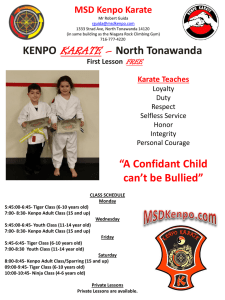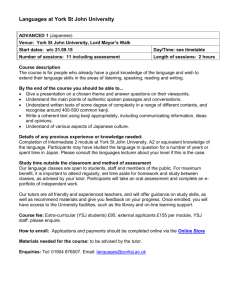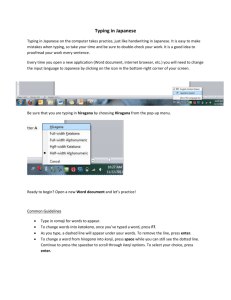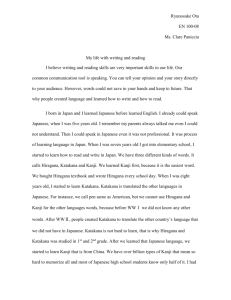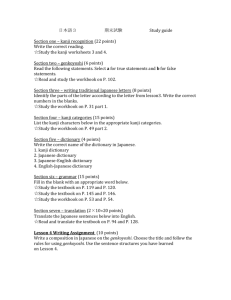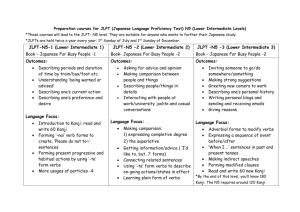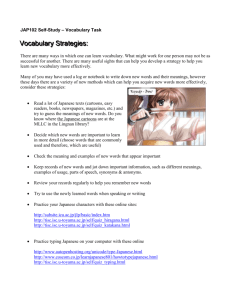Brown_Belt_Thesis
advertisement
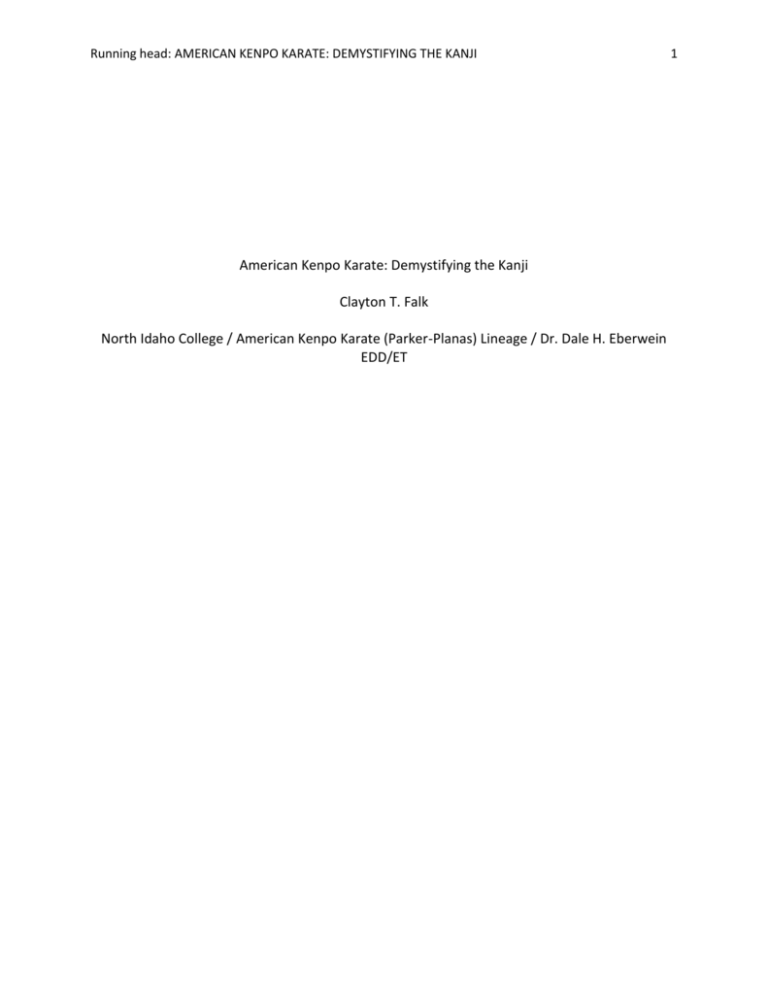
Running head: AMERICAN KENPO KARATE: DEMYSTIFYING THE KANJI American Kenpo Karate: Demystifying the Kanji Clayton T. Falk North Idaho College / American Kenpo Karate (Parker-Planas) Lineage / Dr. Dale H. Eberwein EDD/ET 1 Running head: AMERICAN KENPO KARATE: DEMYSTIFYING THE KANJI American Kenpo Karate: Demystifying the Kanji Throughout many years of studying American Kenpo Karate the patchwork suddenly became very important and interesting. I liken Kenpo to MHC1, the abbreviated version, of major histocompatibility complex I. MHC1 is a biological surface marker on most all of the cells in the human body that recognize self, as self. Everything in Kenpo has a ‘surface marker’ that allows us to identify Kenpo, as Kenpo. Whether it is our basics or vernacular, or simply the motion within our technique’s and kata, they all have identifiable markers and that is what makes Kenpo so great. That is why the patchwork became so suddenly interesting to me. The ‘Kenpo Patch’ is placed over the heart on the left side of the body, and this is symbolic of the writing on the left side of the patch. Through much research I may have stumbled upon the joint writing system, between Japan and China, believed to be completely Chinese within our martial art for many years. There are many different Chinese dialects spoken around the world, and about six different classifications of Chinese characters; “Keisei moji, kaii moji, tenchu moji, shiji moji, shokei moji, and kasha moji (Youshizou, Unknown).” The main dialect or simplest form of Chinese kanji taught to children often times is Shokei moji, this form often uses characters to represent whole complete things or objects such as animals, trees, and other tangible objects. These forms of characters seem to have some Egyptian roots within them such as glyphs and hieroglyphs (Suski, 2010). 2 Running head: AMERICAN KENPO KARATE: DEMYSTIFYING THE KANJI 3 During the time of the Han dynasty Japan did not have a written language, only a verbally spoken one. The first instances of a written language to ever be seen in Japan were by way of “official seals, letters, swords, coins, mirrors, and other objects imported from China or given as gifts from Chinese Emperors to Japanese Emissaries (Anonymous, Gold).” Because these symbols were designed to only be written and read in Chinese, over long periods of time new writing systems in japan began to evolve from Chinese text. The new writing systems involved some new ‘punctuation,’ if you will, that allowed the form and sentence structure of Japan’s verbal system to fit and follow their grammatical structure properly. After changing the word order to fit, some characters became rendered useless, and some no longer made sense within Japan’s sentence structure. Thus began to emerge another writing style to add in between these Kanji characters that represented whole words. The characters added between the kanji are commonly known now today as Kana or the Japanese writing styles of Hiragana and Katakana. When used in conjunction with kanji often times these Kana are used as verbs, adverbs, and helping verbs. But this new kana could be used to stand alone as well. Japanese Hiragana are used to write the own cultures words in their own verbal/writing system, while Katakana is used to represent non-Japanese loanwords such as an American word or American name written in Japanese. Take the name Clayton for example: it would not be written in Hiragana because it is clearly not a Japanese name, but rather, the structure would be slightly modified and written in Katakana as Kureton (Suski, Malatesha, Insup). Kureton (Clayton) is also considered another writing style in itself. Although in Japan they would write the name in Katakana, when spelled in the English language, in our alphabet, it is referred to as Romaji, or the Romanization of the Japanese language. Running head: AMERICAN KENPO KARATE: DEMYSTIFYING THE KANJI 4 There is another instance of proof that Japanese Kanji have roots within Chinese Kanji pertaining to American Kenpo Karate. The more common way to express ‘Karate’ is ‘Empty Hand’ which has the literal translation of ‘without weapons in your hand’. In old China, empty hand was translated into ‘tang hand’ during the tang dynasty (after the Han Dynasty). Tang hand was also referred to as ‘China Hand’ in china, and the world ‘Tang’ is also used to represent ‘China’ in the Japanese language. This is all only verbal translation. However, the kanji character or written for ‘Tang’ is used to represent the word ‘empty’ in the Japanese language (Oriental). So one could see how easily it is to get completely confused within the origins of the two languages. These literal translations between Japan and China have verbal and written connections deep in the roots of both the Han and Tang dynasties somewhere between 57 A.D. and 600 A.D (Anonymous, Gold). The American Kenpo Karate Patch utilizes both the right and the left side of the patch, and is dedicated to this cross-cultural Japanese-Chinese Kanji writing. The writing on the right hand side of the patch (拳 法 唐 手) , as most people within the martial art know, is pronounced as ‘Chuan Fa Tan Chow’ or ‘quán fǎ táng shǒu’ in Japanese Romaji, and is translated into the first two characters being “fist law” or “law of the fist,” more commonly expressed as ‘Kenpo.’ Similarly, last two characters translate into “empty hand” or “open hand,” and the most common way to express that translation, as previously stated, is “Karate” and vice versa. Thus when joined together we receive the translation of ‘law of the fist and empty or open hand’ or ‘Kenpo Karate.’ Most dedicated Kenpo scholars know what the left side of the patch is translated into, but unlike the opposite writing on the patch, do not know the pronunciation in its language of Running head: AMERICAN KENPO KARATE: DEMYSTIFYING THE KANJI 5 origin. After long periods of time and research I have translated each symbol and learned the Hiragana, Katakana, and Romaji spellings of the Kanji as well as their English enunciation. Many kanji generators, books, dictionaries, and charts agree upon at least one common word or meaning symbolic to each of the Kanji characters over the heart on the left side of the patch. Saiga-Jp, 1776 Kanji, the Electronic Dictionary Research and Development Group, Google Translator, and A list of Kokuji all agree upon the following research: Translated: Literally means Dragon Japanese Katakana: リョウ Romaji (English Spelling): Ri Yu O English Enunciation: Dyoh / Riyoh Translated: Literally means ‘Ignorance of Tiger’ For our purposes: ‘Tiger’ is only the first symbols of the following segment: Japanese Hiragana: とらがしら Romaji: To Ra Ga Shi Ra English Enunciation: To Ra / Toe Rahh Running head: AMERICAN KENPO KARATE: DEMYSTIFYING THE KANJI Translated: Literally into ‘Sacred Heart’ or ‘Show’ pertaining to the Katakana (below), however, the Kanji (above) carries the more powerful meaning of Spirit, Mind, Soul, Heart, and or Intention. Japanese Katakana: ショウ Romaji: Shi Yu O English Enunciation: Shyoh Translated: God, The Divinity, The Lord, A Goddess, A Deity. Japanese Hiragana: かみ In this form the literal translation is BITE Romaji: Ka Mi English Enunciation: Kah Mee Translated: Both characters are typically seen together to represent the spirit, sacred, or blessed. Japanese Hiragana: せいしん Romaji: Se I Shi N English Enunciation: Saysheen 6 Running head: AMERICAN KENPO KARATE: DEMYSTIFYING THE KANJI 7 The entire translation: 龍虎精神 Translation: Spirit of the Tiger and Dragon Literal Romaji Translation: Ri Yu O – To Ra - Se I Shi N Pronounced/Enunciated In English: Dyoh Torah SaySheen After translating the patchwork I began to relate the actual physical representations of the Kanji characters to the depictions on the patch. The tiger is symbolic of the ‘physical phase’ or the beginning learning stages of the martial art. The ‘kyu’ belt levels in American Kenpo Karate System. Whilst the dragon is mythical and represents the ‘mind or intellectual study’ of the martial art and is representative of the ‘dan’ or upper division ranking in the American Kenpo Karate System. The last two Kanji together represent the spirit or blessed, I relate these to both thanking our mind for what our body has done throughout the continual study of Kenpo, and to Edmund K. Parker, with his middle initial K for Kealoah or ‘the blessed one’ which is also coincidentally what the singular K at the bottom of the patch represents. Although there are many different Chinese dialects and styles of Kanji to write in, why wouldn’t the American Kenpo Karate Patch be written in one that is completely Chinese? Why does the Kanji on the patch establish both Chinese and Japanese roots? If our system were completely Chinese it would be written in one of the many fore-mentioned Chinese styles, or if Running head: AMERICAN KENPO KARATE: DEMYSTIFYING THE KANJI 8 Kenpo was purely Japanese it would have been written in Hiragana, and if Kenpo was considered Japanese ‘Americanized’ it would have been written in Japanese Katakana. The evolution of the writing system between Japan and China is pertinent in establishing a fact. The fact that specific kanji was chosen for our Kenpo Patch to represent our multi-cultural martial art. It was long believed that the writing on the patch was purely Chinese, but evolution is a perfect example of how Kenpo is related to MHC1. There are always surface markers that are going to tell us where we came from. Running head: AMERICAN KENPO KARATE: DEMYSTIFYING THE KANJI 9 Reference List Anonymous (2000-2012). 1776 Kanji. Retrieved November 30th, 2012, from http://www.1776kanji.com/en/japanese/dictionary/index.php?search=spirit&kanji= Anonymous (2009). Saiga-Jp Kanji Generator. Retrieved November 30th, 2012, from http://www.saiga-jp.com/cgibin/dic.cgi?m=search&sc=0&f=0&j=&g=&e=&s=&rt=0&start=1&sid=1350607095_64864 Anonymous (Unknown). Gold Seal (Kin-in). Retrieved November 30th, 2012, from http://museum.city.fukuoka.jp/english/eb/eb_fr2.html Electronic Dictionary Research and Development Group at Monash University (Unknown). Denshi Jisho Kanji: English<>Japanese. Retrieved November 30th, 2012, from http://jisho.org/words?jap=&eng=Tiger&dict=edict Google (2012). Google Translator: English<>Japanese. Retrieved November 30th, 2012, from http://translate.google.com/ Insup, T., & Taylor, M. M. (1995). Writing And Literacy in Chinese, Korean And Japanese. Location Unknown: John Benjamis Publishing. Malatesha, J. R., & Aaron, P. G. (2006). Handbook Of Orthography And Literacy. Texas A&m University: Taylor & Francis Group. Oriental Outpost (2002-2012). Law of the Fist Karate / Kempo Karate. Retrieved November 30th, 2012, from http://www.orientaloutpost.com/shufa.php?q=chinese+kempo Suski, P. M. (2010). The Phonetics of Japanese Language: With Reference to Japanese Script. Japan: Routledge Library Editions. Running head: AMERICAN KENPO KARATE: DEMYSTIFYING THE KANJI Yoshizou, S. (Unknown). 1.2.5.1. A list of kokuji. Retrieved November 30th, 2012, from http://www.sljfaq.org/afaq/kokuji-list.html 10
